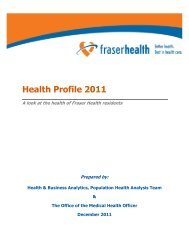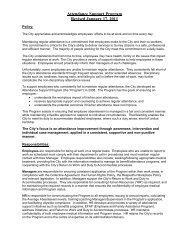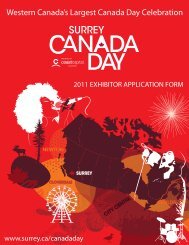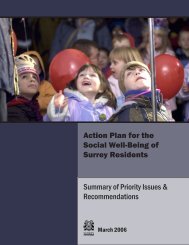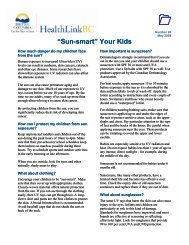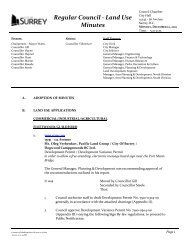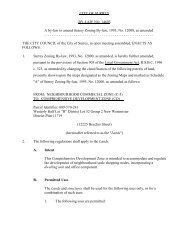Blackie Spit Park: Wildlife Habitat Enhancement Plan - City of Surrey
Blackie Spit Park: Wildlife Habitat Enhancement Plan - City of Surrey
Blackie Spit Park: Wildlife Habitat Enhancement Plan - City of Surrey
You also want an ePaper? Increase the reach of your titles
YUMPU automatically turns print PDFs into web optimized ePapers that Google loves.
3.4 Monitoring Schedule<br />
Monitor the success (in surrounding MUs) <strong>of</strong> invasive species management activities, making<br />
adjustments to procedures, as necessary.<br />
Management Unit 4: Dunsmuir Farm Old-field<br />
1.0 Existing Conditions<br />
Management Unit 4 is primarily an old-field with areas <strong>of</strong> shrub border (Drawing 3). The shrub<br />
border occurs mostly south <strong>of</strong> the community garden (Figure 13) and along the west side. South <strong>of</strong><br />
the community garden, the well established and structurally diverse border contains a large variety<br />
<strong>of</strong> plant species. Some <strong>of</strong> the predominant species are blackberry (both Rubus discolor and R.<br />
laciniatus), elderberry, and black twinberry (Lonicera involucrata), with one to three individuals <strong>of</strong><br />
birch, black hawthorne (Crataegus douglasii), lodgepole pine, and blue spruce. The escaped<br />
herbaceous policeman’s helmet is also abundant in the hedge. The west border <strong>of</strong> MU 4 is composed<br />
<strong>of</strong> blackberry with elderberry and other shrubs.<br />
The fields are characterized by three predominant cover types. The east end exhibits the influence<br />
<strong>of</strong> the community gardens and grasses are dominated by herbaceous plants, including Canada thistle,<br />
bedstraw (Galium sp.), and various horticultural plants (Figure 13).<br />
The southern region is largely short pasture grasses, with significant intrusions <strong>of</strong> thistles, willowherb<br />
(Epilobium ciliatum), Canada goldenrod, hairy cat’s-ear, silverweed (Potentilla anserina), stinging<br />
nettle, common rush (Juncus effusus), and some elderberry (Figure 14).<br />
The north part <strong>of</strong> the field is dominated by reed canarygrass and has approximately a 5% coverage<br />
<strong>of</strong> mature elderberry bushes (Drawing 3) (Figure 14). Many <strong>of</strong> the elderberry bushes are dead or<br />
dying, perhaps from dessication (Figure 14). Lodgepole pines have also been planted in this area.<br />
A shallow drainage ditch runs through the area into the main ditch in MU 6 that drains the adjacent<br />
subdivision.<br />
The extreme north end is becoming overgrown with blackberries. There is a remaining open patch<br />
<strong>of</strong> grass in which some elderberry and planted lodgepole pine are growing, but these, too, are<br />
becoming overtaken by blackberries (Figure 15).<br />
The eastern and southern areas had about 35-60 cm <strong>of</strong> organic topsoil over lenses or mixtures <strong>of</strong> grey<br />
clay and organics. The northern area had 15-30 cm <strong>of</strong> organic and/or mineral soil, which was dry in<br />
late July, over a variable clayey/sandy/gravelly/woody (though largely sandy/gravelly) substrate that<br />
was impenetrable to the soil probe.<br />
<strong>Blackie</strong> <strong>Spit</strong> <strong>Park</strong>: <strong>Wildlife</strong> <strong>Habitat</strong> <strong>Enhancement</strong> <strong>Plan</strong> – Management Unit 4 33



